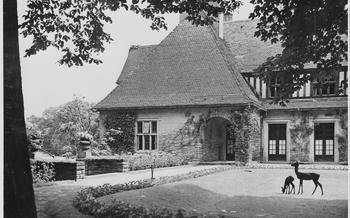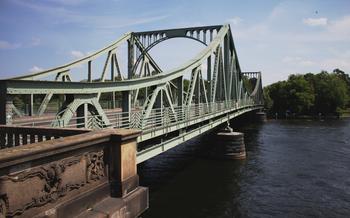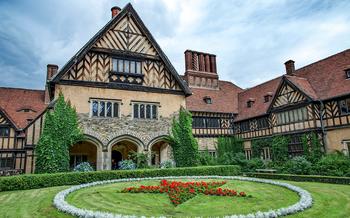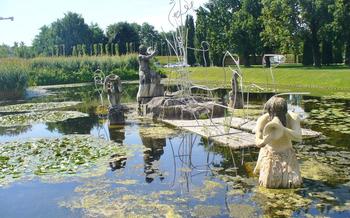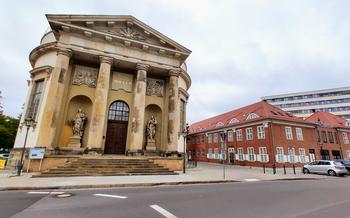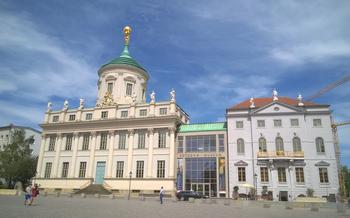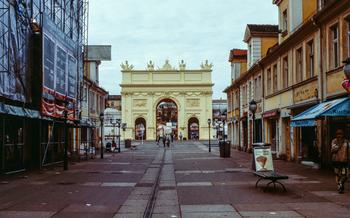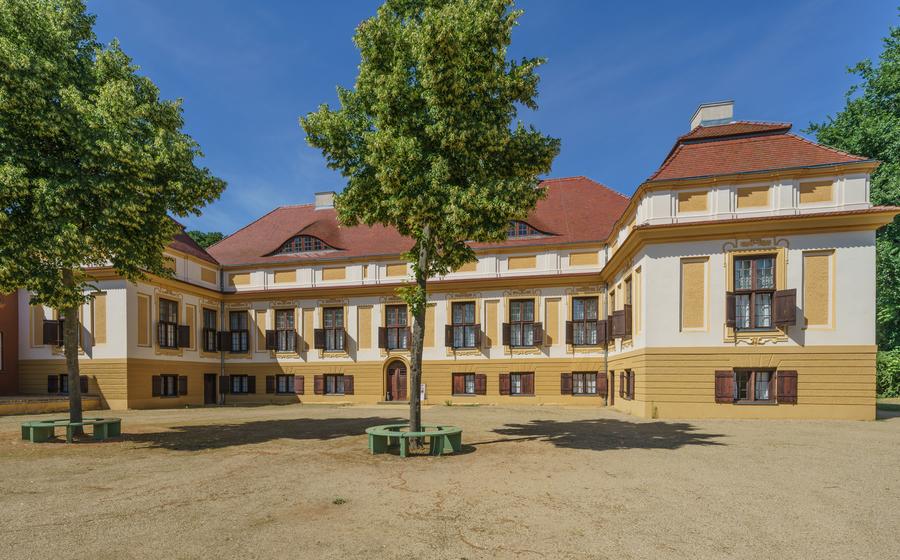
The Caputh Castle (Schloss Caputh)
- Caputh Castle: An Enchanting Gem in Potsdam
- The Royal Residence: A Glimpse into Prussian History
- Baroque Splendor: Exploring the Castle's Interior
- The Orangerie and Marstall: Functional Beauty
- Caputh Church: A Spiritual Haven
- The Village of Caputh: A Charming Retreat
- The Caputh Lake: A Stunning Backdrop
- Potsdam's Cultural Treasures: A Day Trip
- Glienicke Bridge: A Symbol of Unity
- Sanssouci Palace: A Masterpiece of Rococo Architecture
- Cecilienhof Palace: A Glimpse into Royal Life
- The Dutch Quarter: A Historical Neighborhood
- The Film Museum Potsdam: A Cinematic Journey
- Insider Tip: Hidden Gems Off the Beaten Path
Caputh Castle: An Enchanting Gem in Potsdam
Caputh Castle, a magnificent Baroque masterpiece, stands as a testament to the architectural prowess and rich history of Potsdam. Constructed in the early 18th century as a summer residence for the Prussian royal family, this enchanting castle boasts a captivating history intertwined with notable historical figures and events. Its striking architectural features, including the grand entrance, intricate carvings, and elegant facades, reflect the Baroque style's grandeur and opulence. Immerse yourself in the castle's allure as you explore its beautifully landscaped park, adorned with sculptures, fountains, and meticulously manicured gardens. Plan your visit to Caputh Castle and discover the captivating stories and treasures that await you within its walls. The castle is open to the public, offering guided tours that provide insights into the lives of the Prussian royalty and the significance of this architectural gem. Don't miss the opportunity to step back in time and experience the splendor of Caputh Castle, a true masterpiece of Prussian heritage.
The Royal Residence: A Glimpse into Prussian History
Caputh Castle holds a significant place in Prussian history, serving as a favored summer retreat for Prussian royalty. King Frederick William I, known as the "Soldier King," was particularly fond of the castle and spent considerable time there. During his reign, the castle underwent extensive renovations and expansions, transforming it into a grand and opulent residence fit for a king.
Notable historical figures associated with Caputh Castle include Frederick the Great, who succeeded his father Frederick William I and continued the tradition of using the castle as a summer residence. Frederick the Great hosted lavish parties and gatherings at Caputh, inviting prominent figures from the Prussian court and beyond. The castle's walls witnessed many important events, including diplomatic meetings, royal celebrations, and intimate gatherings.
Stories and anecdotes from the castle's past add to its allure. One famous tale speaks of a secret tunnel connecting Caputh Castle to the nearby village, allowing the royal family to move discreetly between the two locations. Another story recounts a grand masquerade ball held at the castle, where Frederick the Great himself donned a disguise to mingle with his guests incognito. These tales offer a glimpse into the lives and pastimes of the Prussian royalty who once graced the halls of Caputh Castle.
The presence of the Prussian royal family had a profound impact on the region. Their patronage and support contributed to the development of Caputh and its surroundings. The construction and expansion of the castle, along with the establishment of the surrounding park, brought economic growth and prosperity to the area. The royal family's love for the arts and culture also influenced the region's cultural landscape, attracting artists, musicians, and scholars to Caputh.
Baroque Splendor: Exploring the Castle's Interior
The interior of Caputh Castle is a testament to the grandeur and opulence of the Prussian royal family. The grand entrance hall, with its soaring ceilings and elegant staircase, sets the tone for the rest of the castle. The elaborately decorated rooms, each with its own unique character, showcase the finest in Baroque craftsmanship.
The Great Hall, the largest and most impressive room in the castle, is adorned with intricate stucco work, crystal chandeliers, and a stunning painted ceiling. The White Room, used for official receptions, features delicate white and gold paneling and a collection of valuable porcelain. The Green Room, named for its lush green silk wall coverings, was the private chamber of Queen Elisabeth Christine. It features a beautifully carved fireplace and a balcony overlooking the park.
Hidden treasures and intriguing details can be found throughout the castle. Look for the secret door leading to the royal apartments, the hidden staircase to the tower, and the collection of antique furniture and artwork. Guided tours and audio guides are available to provide a deeper understanding of the castle's history and architecture.
The Orangerie and Marstall: Functional Beauty
The Caputh Castle complex includes two significant auxiliary structures: the orangerie and the marstall. These buildings served distinct purposes and contributed to the castle's overall functionality.
The orangerie, built in the 17th century, was designed to house exotic plants, particularly citrus trees, during the winter months. Its large windows and carefully controlled temperature provided an ideal environment for these delicate plants. In the summer, the trees were moved outdoors, adding a touch of greenery and fragrance to the castle grounds. Today, the orangerie serves as an exhibition space for contemporary art, showcasing the works of both local and international artists.
The marstall, constructed in the 18th century, served as a stable for the royal horses. It was designed to accommodate up to 24 horses and included a riding hall for training and exercise. The building's impressive size and sturdy construction reflect its importance in supporting the equestrian activities of the Prussian court. Today, the marstall has been converted into a multi-functional event space, hosting concerts, conferences, and other gatherings. Its unique atmosphere and historical charm make it a popular venue for special occasions.
These two buildings, though distinct in their functions, contribute to the architectural harmony of the Caputh Castle complex. Their practical designs and elegant facades complement the main castle building, creating a cohesive ensemble that reflects the grandeur and functionality of the Prussian court.
Caputh Church: A Spiritual Haven
Nestled amidst the tranquil landscapes of Caputh, the Caputh Church stands as a testament to the village's rich history and spiritual heritage. Constructed in the 13th century, the church underwent significant renovations and expansions in the 17th and 18th centuries, resulting in a harmonious blend of architectural styles.
Historical Significance: Caputh Church holds a special place in the hearts of the local community, serving as a spiritual sanctuary and a witness to significant historical events. Over the centuries, the church has borne witness to the changing fortunes of Caputh, from its humble beginnings as a fishing village to its transformation into a popular destination for Prussian royalty and nobility.
Architectural Features: The church's exterior showcases a harmonious blend of Gothic and Baroque elements, with its striking stepped gables and intricate stone carvings. Inside, visitors are greeted by a luminous and serene atmosphere, thanks to the large windows that flood the space with natural light. The interior boasts a simple yet elegant design, featuring a wooden barrel-vaulted ceiling and whitewashed walls adorned with delicate frescoes.
Notable Artwork: Among the church's most notable features is the stunning altarpiece, crafted in the late 17th century. The altarpiece depicts scenes from the life of Jesus Christ, rendered in intricate detail and vibrant colors. Other notable artworks include a series of 18th-century stained glass windows depicting biblical scenes, as well as a beautifully carved wooden pulpit.
Community and Connection to the Castle: Caputh Church has always played an integral role in the life of the local community, serving as a place of worship, community gatherings, and religious celebrations. The church's close proximity to Caputh Castle further reinforces its historical connection to the Prussian royal family, who often attended services here during their summer retreats.
Guided Tours and Services: To delve deeper into the rich history and spiritual significance of Caputh Church, guided tours are available upon request. These tours provide visitors with insights into the church's architecture, artwork, and its role in the community. Regular religious services are also held, offering visitors an opportunity to experience the church's sacred atmosphere firsthand.
The Village of Caputh: A Charming Retreat
Nestled amidst picturesque landscapes, the village of Caputh exudes a timeless charm that captivates visitors. With its cobblestone streets, traditional architecture, and tranquil atmosphere, Caputh offers a welcome respite from the hustle and bustle of city life.
Strolling through the village, visitors can admire the well-preserved historical landmarks and notable buildings that line the streets. The village church, dating back to the 13th century, stands as a testament to Caputh's rich history. The Caputh Town Hall, with its distinctive red brick facade, adds to the village's unique character.
Caputh is home to a variety of charming local shops, restaurants, and cafes that offer regional cuisine and warm hospitality. Visitors can savor delicious meals made with fresh, local ingredients while enjoying the relaxed ambiance of the village.
For those seeking a tranquil stay, Caputh offers a range of accommodation options, including cozy guesthouses, comfortable hotels, and idyllic vacation rentals. Whether you prefer a charming cottage by the lake or a modern apartment in the heart of the village, Caputh has something to suit every taste and budget.
The Caputh Lake: A Stunning Backdrop
The Caputh Lake is an integral part of the Caputh experience, offering a captivating landscape that complements the historical charm of the village. Its serene waters, surrounded by lush greenery, create a picturesque backdrop for leisurely strolls, cycling adventures, and water-based activities.
Whether you prefer the tranquility of fishing, the thrill of sailing, or the excitement of rowing, the lake provides ample opportunities to embrace the natural beauty of the region. Take a leisurely boat ride to soak in the panoramic views, or simply relax on the shore and let the gentle lapping of the waves transport you to a state of serenity.
The lake's crystal-clear waters invite swimmers to plunge in and cool off on warm summer days, while the scenic trails along the lakeshore beckon hikers and cyclists to explore the surrounding landscapes. As the sun sets, the lake transforms into a canvas of vibrant colors, casting a magical glow upon the village and creating a picturesque spectacle that will leave you in awe.
Potsdam's Cultural Treasures: A Day Trip
Potsdam is renowned for its rich cultural heritage, boasting UNESCO World Heritage status. While in Caputh, take advantage of the opportunity to explore Potsdam's captivating attractions. The city is home to numerous museums, palaces, and gardens that offer a glimpse into its regal past and vibrant artistic scene.
Start your journey at the Sanssouci Palace, an exquisite summer palace built by Frederick the Great in the 18th century. Marvel at its elegant Rococo architecture and explore its lavish interior, adorned with intricate artwork and opulent furnishings. The palace is surrounded by breathtaking gardens, featuring manicured lawns, colorful flowerbeds, and serene fountains, inviting you to stroll amidst its serene beauty.
Continue your exploration at the Cecilienhof Palace, a magnificent residence constructed in the early 20th century. This palace holds historical significance as the venue for the Potsdam Conference in 1945, where the fate of postwar Europe was decided. Today, it serves as a museum, showcasing exhibits on the conference and the palace's history.
Discover the Dutch Quarter, a charming neighborhood dating back to the 18th century. Admire its unique architecture, characterized by red-brick facades and gabled roofs, reminiscent of traditional Dutch towns. Explore the narrow streets, lined with quaint shops, galleries, and cafes, offering a glimpse into Potsdam's rich cultural diversity.
Immerse yourself in the world of cinema at the Film Museum Potsdam, a must-visit for movie enthusiasts. This renowned museum houses a vast collection of film artifacts, including costumes, props, and cameras, chronicling the history of German cinema. Engage in interactive exhibits and educational programs that shed light on the art of filmmaking and its impact on society.
With easy transportation options available from Caputh, planning a day trip to Potsdam is a breeze. Hop on the S-Bahn or regional train, which will take you to Potsdam's city center in just 20 minutes. Once there, purchase a Potsdam Pass, which grants you access to numerous attractions, including museums, palaces, and gardens, at a discounted price.
Whether you're an art aficionado, history buff, or simply seeking a day of cultural exploration, Potsdam offers a wealth of experiences to satisfy your curiosity.
Glienicke Bridge: A Symbol of Unity
The Glienicke Bridge, also known as the Bridge of Unity, holds a significant place in German history, symbolizing the reunification of East and West Germany after the fall of the Berlin Wall. Constructed in 1907, the bridge spans the Havel River, connecting the districts of Wannsee and Potsdam. Its elegant design, featuring intricate ironwork and decorative elements, makes it a striking landmark in the region.
The bridge gained international prominence during the Cold War when it served as a crossing point for spies and defectors between East and West Berlin. This earned it the nickname "Bridge of Spies." The famous exchange of captured spies between the United States and the Soviet Union took place on the bridge in 1962, an event immortalized in the 2015 film "Bridge of Spies."
After the reunification of Germany in 1990, the Glienicke Bridge became a symbol of unity and reconciliation. Today, it stands as a reminder of the country's tumultuous past and its triumph over division. The bridge is a popular tourist destination, offering stunning views of the surrounding landscape and a glimpse into a pivotal chapter of German history.
Sanssouci Palace: A Masterpiece of Rococo Architecture
Sanssouci Palace, the epitome of Prussian elegance, stands as a testament to the grandeur of the 18th century. Commissioned by Frederick the Great in 1745, this idyllic summer residence embodies the essence of Rococo architecture, a style characterized by its intricate ornamentation, delicate pastel hues, and graceful curves.
Designed by Georg Wenzeslaus von Knobelsdorff, Sanssouci Palace exudes an air of sophistication and harmony. Its single-story structure, adorned with elaborate carvings, stucco work, and gilded details, reflects the artistic sensibilities of the era. The palace's opulent interior matches its captivating exterior, boasting a series of elegantly appointed rooms, each adorned with intricate tapestries, shimmering chandeliers, and exquisite furniture.
The palace's name, which translates to "without worries," aptly captures the essence of this serene retreat. Set amidst meticulously manicured gardens and sparkling fountains, Sanssouci provided Frederick with a tranquil haven away from the pressures of his royal duties. Here, he could indulge in his passions for music, philosophy, and the arts, surrounded by the beauty of nature.
Today, Sanssouci Palace stands as a UNESCO World Heritage Site, attracting visitors from around the world who come to admire its architectural splendor and immerse themselves in its rich history. Guided tours and exhibitions offer a glimpse into the life of Frederick the Great and the vibrant cultural milieu of the Prussian court.
Cecilienhof Palace: A Glimpse into Royal Life
Amidst the verdant landscapes of Potsdam, nestled in the captivating Neuer Garten park, lies Cecilienhof Palace, a testament to regal history and architectural splendor. Built between 1914 and 1917, this elegant palace served as the last residence of the German Crown Prince Wilhelm and his wife, Cecilie. Its unique blend of English Tudor and Dutch Renaissance architectural styles reflects the Crown Prince's fascination with English culture.
Step into the palace's grand entrance hall and be greeted by an awe-inspiring staircase, intricately adorned with ceramic tiles depicting scenes from German history. Wander through its opulent rooms, each adorned with exquisite furniture, tapestries, and artwork that narrate tales of royal life. The Music Room, with its grand piano and intricate wood carvings, evokes memories of musical evenings that once filled the palace with melodies.
Cecilienhof Palace holds a significant place in history as the venue for the Potsdam Conference in 194During this pivotal event, the leaders of the Allied powers—Harry S. Truman, Winston Churchill, and Joseph Stalin—gathered to decide the fate of postwar Germany. The palace's elegant rooms served as the backdrop for crucial discussions that shaped the course of history.
Today, Cecilienhof Palace stands as a living testament to the grandeur of the German monarchy and the complexities of 20th-century history. Guided tours offer visitors a glimpse into the lives of the royal family and the momentous events that unfolded within its walls. As you explore the palace's opulent chambers, you'll be transported back in time to an era of elegance, power, and intrigue.
The Dutch Quarter: A Historical Neighborhood
Nestled along the banks of the Havel River, the Dutch Quarter is a charming neighborhood that stands as a testament to Potsdam's rich history and cultural diversity. Founded in the 17th century by Dutch immigrants invited by Frederick William, the Great Elector, the neighborhood was designed to replicate the canals and gabled houses of the Netherlands.
Strolling through the Dutch Quarter is like stepping back in time. The narrow streets are lined with beautifully preserved red-brick townhouses, each with its unique charm and character. The houses feature distinctive stepped gables, intricate brickwork, and charming courtyards, creating a picturesque atmosphere.
Notable landmarks and attractions within the Dutch Quarter include the Dutch Church, built in 1685, and the Friendship Island, a small island in the Havel River connected to the neighborhood by a bridge. The island features a beautiful park, a restaurant, and a stunning view of the surrounding area.
Visitors to the Dutch Quarter can also enjoy a variety of shops, cafes, and restaurants, many of which offer traditional Dutch cuisine. The neighborhood also hosts regular events and festivals throughout the year, celebrating its unique heritage and vibrant community spirit.
The Film Museum Potsdam: A Cinematic Journey
Nestled in the heart of Potsdam's cultural district, the Film Museum Potsdam is a treasure trove for movie enthusiasts. Established in 1981, the museum is dedicated to preserving and showcasing the rich history of filmmaking in Germany and beyond.
Within its walls, visitors can embark on a cinematic journey through time, exploring the evolution of film technology, from early silent films to modern digital productions. The museum's extensive collection includes cameras, projectors, editing equipment, costumes, props, and posters, offering a glimpse into the behind-the-scenes magic of filmmaking.
Interactive exhibits and educational programs bring the world of cinema to life, allowing visitors to experience the art of filmmaking firsthand. Hands-on activities, workshops, and film screenings provide a deeper understanding of the creative process and the impact of cinema on society.
Temporary exhibitions showcase the latest trends and innovations in film technology, featuring works by contemporary filmmakers and exploring emerging genres and styles. The museum also hosts film festivals, lectures, and discussions, creating a platform for dialogue and exchange among filmmakers, critics, and audiences.
Whether you're a cinephile, a history buff, or simply curious about the world of cinema, the Film Museum Potsdam offers a captivating experience that will transport you to the silver screen and ignite your passion for the art of filmmaking. So, grab your popcorn and prepare to be immersed in the magic of movies!
Insider Tip: Hidden Gems Off the Beaten Path
Beyond the well-known attractions, Potsdam offers a wealth of hidden gems waiting to be discovered. For those seeking a unique experience, venture off the beaten path to uncover the city's lesser-known treasures. Explore the historic neighborhoods, such as Nauener Vorstadt, with its charming streets and colorful buildings. Discover hidden courtyards, tucked away gardens, and intimate cafes that offer a glimpse into local life. Visit the Potsdam Science Park, a vibrant hub of innovation and research, where you can learn about cutting-edge scientific advancements. Take a leisurely stroll along the Havel River, enjoying picturesque views and spotting local wildlife. Potsdam is full of surprises, so embrace your curiosity and let your feet guide you to hidden gems that will create lasting memories.

